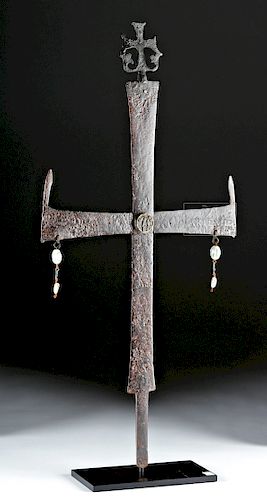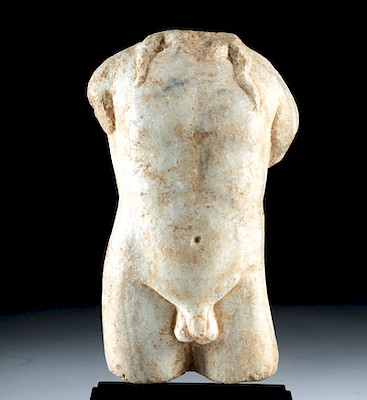Published Large Byzantine Copper-Iron & Bronze Cross
Lot 69
About Seller
Artemis Fine Arts
686 S Taylor Ave, Ste 106
Louisville, CO 80027
United States
Selling antiquities, ancient and ethnographic art online since 1993, Artemis Gallery specializes in Classical Antiquities (Egyptian, Greek, Roman, Near Eastern), Asian, Pre-Columbian, African / Tribal / Oceanographic art. Our extensive inventory includes pottery, stone, metal, wood, glass and textil...Read more
Estimate:
$12,000 - $18,000
Absentee vs Live bid
Two ways to bid:
- Leave a max absentee bid and the platform will bid on your behalf up to your maximum bid during the live auction.
- Bid live during the auction and your bids will be submitted real-time to the auctioneer.
Bid Increments
| Price | Bid Increment |
|---|---|
| $0 | $25 |
| $300 | $50 |
| $1,000 | $100 |
| $2,000 | $250 |
| $5,000 | $500 |
| $10,000 | $1,000 |
| $20,000 | $2,500 |
| $50,000 | $5,000 |
| $100,000 | $10,000 |
| $200,000 | $20,000 |
About Auction
By Artemis Fine Arts
Dec 5, 2018
Set Reminder
2018-12-05 10:00:00
2018-12-05 10:00:00
America/New_York
Bidsquare
Bidsquare : DAY 1 | Classical Antiquities & Asian Art
https://www.bidsquare.com/auctions/artemis-gallery/day-1-classical-antiquities-asian-art-3698
Day 1 of an important 2-day auction featuring ancient and ethnographic art from around the world. Egyptian, Greek, Roman, Viking, Near Eastern plus Asian Art from China, Japan, Thailand, Vietnam, Burma, India, more. Artemis Fine Arts info@artemisfinearts.com
Day 1 of an important 2-day auction featuring ancient and ethnographic art from around the world. Egyptian, Greek, Roman, Viking, Near Eastern plus Asian Art from China, Japan, Thailand, Vietnam, Burma, India, more. Artemis Fine Arts info@artemisfinearts.com
- Lot Description
Ancient Near East / Holy Land, Byzantine Empire, ca. 12th to 14th century CE. An exquisite cast copper-iron processional cross composed of two flared sections pinned together in the center with a cast-bronze medallion. The lateral arms have pointed finials on their upper corners, and on top is an intricate bronze crucifix finial flanked by palmettes. From each arm hangs a pair of suspended rock crystal beads, and a large tang projects from beneath the vertical arm. The circular bronze medallion is ringed with faint silvering and displays an image of the Virgin Mary and the infant Christ. A pointille Greek inscription on the obverse side reads, "SOFRONIYO," possibly an inexact genitive name form of "Sofronios," perhaps the individual responsible for dedicating the cross. Another inscription on the horizontal arms, though faded on the left arm, reads, "…IA KONYA," perhaps a reference to the modern city of the same name. Custom museum-quality display stand included. Size: 12.7" W x 26.875" H (32.3 cm x 68.3 cm); 27.625" H (70.2 cm) on included custom stand.
The Byzantine Empire was established in the 4th century CE when the Emperor Constantine, also known as Saint Constantine, Christianized the Roman Empire and pronounced the city of Constantinople in Byzantium as the capital. The visual culture of this era demonstrates a synthesis of classical Greek, Roman, and Christian influences.
Published in "Venerable Traditions: Works of Art from the Ancient World." Fortuna Fine Arts, Ltd., New York, 2007.
Provenance: private East Coast, USA collection; ex-Janet Zakos collection, Switzerland, acquired in the 1980s
All items legal to buy/sell under U.S. Statute covering cultural patrimony Code 2600, CHAPTER 14, and are guaranteed to be as described or your money back.
A Certificate of Authenticity will accompany all winning bids.
We ship worldwide and handle all shipping in-house for your convenience.
#140287Repair to finial on left arm with some small losses along break line. Slight bending to overall form, wear to silvering on central medallion, fading to pointille inscriptions, minor nicks to bottom tang, lateral arms, vertical bar, and finials, and heavy pitting across most surfaces. Light earthen deposits and great oxidized patina throughout. Old inventory label on base of stand.Condition
- Shipping Info
-
All shipping is handled in-house for your convenience. Your invoice from Artemis Gallery will include shipping calculation instructions. If in doubt, please inquire BEFORE bidding for estimated shipping costs for individual items.
-
- Buyer's Premium



 EUR
EUR CAD
CAD AUD
AUD GBP
GBP MXN
MXN HKD
HKD CNY
CNY MYR
MYR SEK
SEK SGD
SGD CHF
CHF THB
THB
















